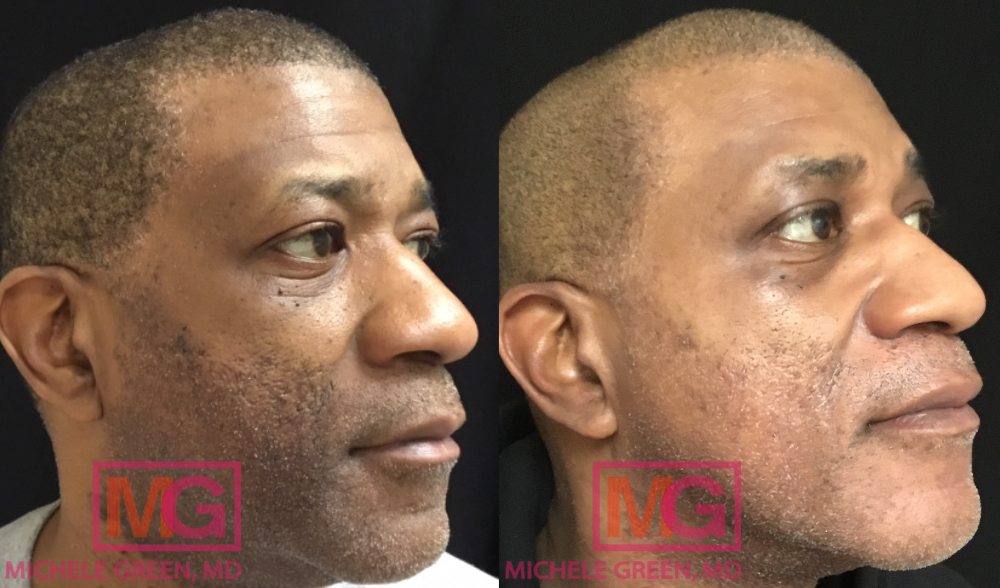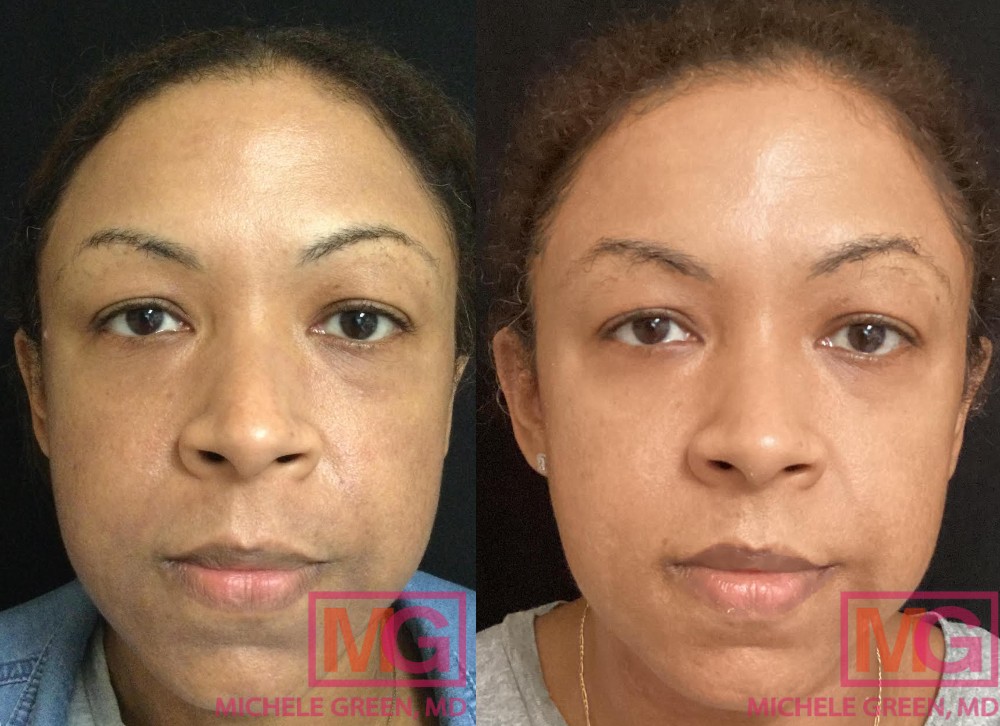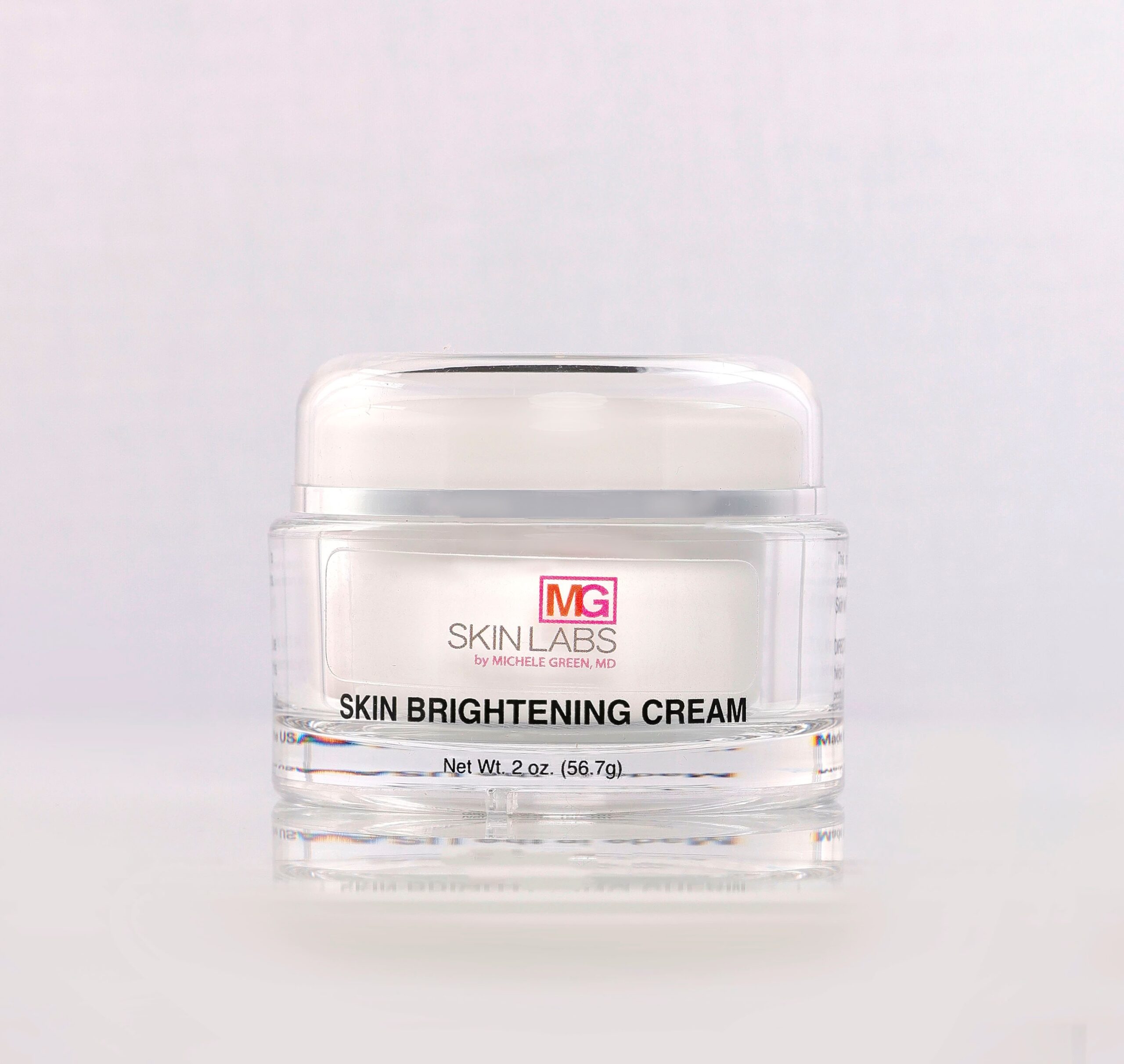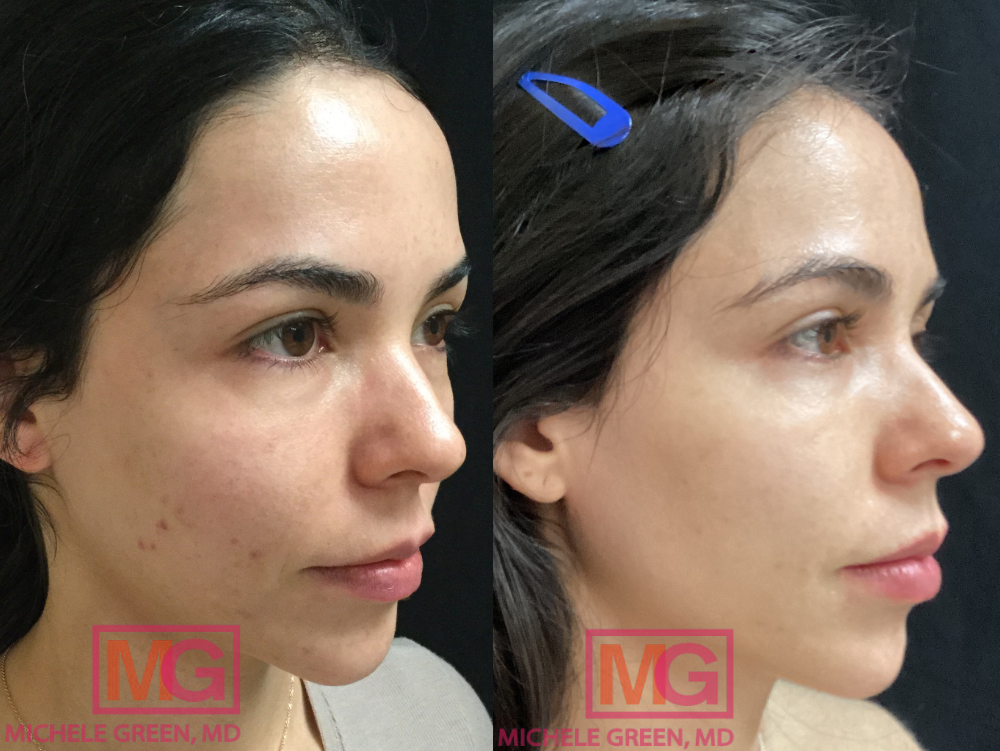Microneedling for Hyperpigmentation
Hyperpigmentation occurs when excess melanin is produced in the skin, creating dark spots and uneven skin tone. Skin discoloration can be caused by a number of factors, including sun damage (sun spots, age spots), hormonal changes, acne scars, or post-inflammatory hyperpigmentation associated with scarring or injury. While forms of hyperpigmentation are extremely common, discoloration and uneven skin tone can still be a skin concern for many people, leading many to wonder what the best treatment options and cosmetic procedures are. Luckily, many treatment options are available at the expert board-certified dermatologist, Dr. Michele Green’s, New York City dermatology office, including laser treatments, skincare products, and microneedling.
Microneedling is a collagen-induction therapy that uses the body’s natural healing process to boost new collagen production and skin cell turnover for brighter, clearer, smoother skin. When it comes to treating hyperpigmentation, including sun spots, acne scars, melasma, and post-inflammatory hyperpigmentation, Dr. Green will often turn to microneedling, as it is safe and effective for use on patients of all skin types and skin tones, including patients with darker skin tones for whom laser therapies are not always safe. Microneedling treatment uses fine needles to create controlled micro-injuries to the skin, triggering the body’s wound healing process to synthesize new collagen and elastin. The results are more even skin tone, reduced discoloration, and clear, bright, youthful-looking new skin all without the need for any downtime. Microneedling can also be paired with additional treatments like platelet-rich plasma (PRP), skin lightening serums, dermal fillers, Botox, and laser therapies for optimal results. To find out which treatment or series of treatments is best for your aesthetic goals, schedule your initial consultation with Dr. Green.
Experienced board-certified dermatologist Dr. Michele Green has been masterfully treating patients in her Upper East Side New York City dermatology office for more than 25 years. With her proprietary range of skincare products, MGSKINLABs, Dr. Green is an expert in providing patients with individualized treatment plans tailored to their skin type and aesthetic goals. Whether you are concerned about skin disorders, hyperpigmentation, dark spots, melasma, or signs of the natural aging process, Dr. Green has plenty of treatment options available. In addition to generating individualized skincare plans, Dr. Green has a range of in-office treatments that can help with hyperpigmentation management and treatment, including chemical peels, mesopeels, microneedling, microdermabrasion, laser treatments, and Cosmelan peels. Well-known for high patient satisfaction, Dr. Green has been voted one of the best dermatologists in New York City by such publications as Castle Connolly, Super Doctors, and New York Magazine.
What is Microneedling treatment?
Microneedling treatment—also known as collagen-induction therapy—is a cosmetic procedure that triggers collagen and elastin production for full skin rejuvenation. The procedure uses a microneedling device composed of tiny needles that puncture the dermis to cause controlled micro-injuries, which triggers the body’s natural wound-healing response. As a result, the body produces new collagen and elastin, boosting skin cell turnover for improved skin texture, tone, and elasticity. Microneedling treatment can be used to treat a wide range of skin concerns, including fine lines, wrinkles, hyperpigmentation, large pores, uneven skin texture, uneven skin tone, acne scars, stretch marks, and melasma.
Can Microneedling remove dark spots?
Yes! Microneedling is a highly effective treatment option for removing dark spots and addressing various forms of hyperpigmentation, including sun spots, age spots, melasma, and uneven skin tone. In addition to boosting new collagen production and triggering skin cell turnover, microneedling can disrupt melanin production in the skin by reducing the activity of the melanocytes, which are responsible for creating pigmentation in the skin. One benefit of microneedling is that the microchannels created allow for increased absorption of topical serums. During the microneedling procedure, a depigmentation serum can be applied to the skin to enhance the skin lightening results and more effectively remove dark spots.

How does Microneedling work on acne scars and hyperpigmentation?
Microneedling works well to address the appearance of atrophic acne scars by boosting the body’s production of collagen to fill in depressions on the surface of the skin. The procedure works via the application of tiny, surgical-grade needles that pierce the skin, creating small micro-injuries, which triggers the body’s natural healing response. As a result, collagen production increases, which repairs the skin at the treatment site, leading to smoother, clearer, more even-textured skin. When paired with platelet-rich plasma infusions, the effects of the treatment are even more apparent.
The cosmetic procedure uses a similar principle to address hyperpigmentation in the dermis. Hyperpigmentation occurs when there is an overproduction of melanin in the skin, which is the substance in your body responsible for pigmentation. When the microneedling device punctures the skin, the natural wound-healing response triggers the production of new skin, which reduces the appearance of dark spots in the treatment area. To achieve optimal results, Dr. Green recommends that patients schedule 3-6 treatment sessions each spaced approximately four weeks apart.
Does Microneedling help with hyperpigmentation?
Patients often ask, “Can microneedling help with hyperpigmentation?” Microneedling is a highly effective treatment option for addressing hyperpigmentation, including sun spots, age spots, melasma, and post-inflammatory hyperpigmentation. Microneedling is most effective when performed by an experienced board-certified dermatologist, such as Dr. Michele Green, who will choose the microneedling device and needle depth that is most appropriate for the treatment area. Typically, when treating the face, the needle depth is 0.3 to 0.5 mm while needle depth for the neck and chest can range from 1.5 to 3 mm. Dr. Green often pairs microneedling with a depigmentation serum containing skin lightening and brightening ingredients to reduce hyperpigmentation. Microneedling is approved for treatment on many areas of the body, including the face, neck, chest, arms, legs, and back.

Is Microneedling safe for all skin tones?
Microneedling is a safe and effective treatment for patients of all skin types and skin tones. When seeking out a dermatologist or healthcare provider to treat hyperpigmentation, it is essential to choose someone who knows which treatments are safe for patients with darker skin tones. Some treatments, such as laser therapies, can damage patients with darker skin, leading to scarring, post-inflammatory hyperpigmentation, or hypopigmentation. Dr. Green is an expert in treating patients of all skin tones, carefully choosing the treatment option that will be safe for each individual. Patients with skin conditions like eczema and psoriasis, active acne, or herpes infections may not be good candidates for microneedling. It is best to wait until symptoms have resolved before receiving microneedling treatment. Patients with a history of keloid scarring may also not be good candidates. If you are interested in microneedling, schedule a consultation with Dr. Michele Green to learn if you are a good candidate for the procedure.
What is the procedure like for Microneedling with a depigmentation serum?
The first step in treating hyperpigmentation with microneedling is to schedule a consultation with Dr. Green. She will assess your medical history and skin concerns to ensure that you are a good candidate for treatment. Medical photography may be taken to track future progress with treatment. Depending on your schedule, the procedure can be performed on the same day as your consultation.
An hour before the procedure, a topical numbing cream should be applied to the skin to reduce any discomfort. When you arrive at Dr. Green’s office, the skin will be cleaned and sterilized for treatment. Dr. Green will glide the microneedling handpiece across the surface, creating micro-channels in the skin to stimulate collagen and elastin production. The topical depigmentation serum will then be applied onto the skin. The depigmentation serum contains a unique blend of skin lightening ingredients that can inhibit melanin production and reduce melanocyte activity. With the addition of the depigmentation serum, patients can look forward to reduced hyperpigmentation and dark spots and a more even-toned complexion. After treatment, Dr. Green will provide you with all the pertinent aftercare for treatment.
What are the side effects of Microneedling treatment?
When microneedling is performed by an expert board-certified dermatologist, such as Dr. Green, the treatment is not associated with significant side effects or downtime. Post-treatment, patients may experience some common, mild side effects, including redness, swelling, some bleeding, dryness, or flaking. However, these side effects will resolve on their own without the need for any intervention. Serious side effects can occur when microneedling treatment is performed by an unqualified provider or with an at-home dermaroller device. In these cases, microneedling treatment can lead to infection, skin damage, scarring, or post-inflammatory hyperpigmentation.
What is the best at-home skincare routine after Microneedling treatment?
Following your microneedling treatment, Dr. Green recommends following a skincare plan that will keep the skin clean, hydrated, and protected from the sun. Patients should avoid cleansing the skin for 24 hours, as the topical depigmentation serum is still being absorbed into the microchannels created by the microneedling device. If dryness occurs throughout the day, Dr. Green suggests that patients turn to Hydra Repair moisturizing cream. With a high concentration of hyaluronic acid, Hydra Repair provides the skin with the essential moisture and hydration it needs through recovery. This product can be used multiple times throughout the day as needed, as it is important to keep the skin hydrated.
The next day, Dr. Green recommends using a gentle cleanser, such as the MGSKINLABs Gentle Cleanser. While the skin heals, Dr. Green advises that patients continue to use a gentle cleanser and the Hydra Repair. Patients must use sunscreen and practice proper sun protection after treatment, as the skin will be sensitive to the sun’s UV rays. To protect the skin from additional damage and hyperpigmentation, patients should apply a broad-spectrum sunscreen of SPF 50 every morning before leaving the house. MGSKINLABs Hydrating SPF 50 is an excellent sunscreen choice, containing zinc oxide to protect the skin from sun damage in addition to hyaluronic acid and lactic acid to hydrate and soften the skin.
To enhance the results from treatment, Dr. Green may recommend adding skin-lightening ingredients or products to your skincare routine. Vitamin C is an excellent skincare ingredient for anyone with hyperpigmentation due to its ability to accelerate skin cell turnover and brighten the skin. The Vita-C Serum from MGSKINLABs contains a high potency of vitamin C to create a brighter and more even skin tone. The Skin Brightening Cream is another fantastic product for treating dark spots and hyperpigmentation. This cream is formulated with proven skin lightening ingredients, including kojic acid, glycolic acid, lactic acid, and fruit extracts, to reduce hyperpigmentation and rejuvenate the skin.
In some cases, Dr. Green may recommend hydroquinone, a skin-lightening agent that inhibits melanin production and controls melanocyte activity. Hydroquinone comes in various strengths and can only be prescribed by a board-certified dermatologist. As it increases the skin’s sensitivity to the sun, it is imperative to practice proper sun protection and wear sunscreen when using it.

Microneedling for Hyperpigmentation FAQs
How does Microneedling help hyperpigmentation?
Microneedling is a highly effective treatment option for reducing hyperpigmentation and dark spots on the skin’s surface. Microneedling sessions can also be combined with the application of Platelet Rich Plasma, which can aid in the healing process and further boost collagen production, or skin lightening vitamin C serums, which improve the treatment results. When the tiny needles pierce the top layer of skin, the treatment induces the body’s natural healing response, which leads to the production of new skin, which is smoother and brighter than before. Microneedling is an excellent way to improve the appearance of aging or discolored skin on the face, neck, arms, legs, chest, back, and hands, and microneedling is a treatment that can be safely used for any skin type and skin tone.
Is Microneedling good for hyperpigmentation?
Microneedling can be used to treat a wide variety of skin conditions and address many signs of aging. The treatment is effective in addressing forms of discoloration and hyperpigmentation, including melasma, dark spots, and sun spots, with an overall brightening effect. Microneedling treatment is also good to treat acne scars, particularly depressed acne scars, such as rolling scars, icepick scars, and boxcar scars. When it comes to fine lines and wrinkles, microneedling can naturally reduce the appearance of creases for tighter, smoother skin. Overall, the treatment is excellent for improving skin texture and tone, and tightening the skin for a naturally youthful appearance.
Is Microneedling good for melasma?
Melasma is a skin condition characterized by areas of pigmentation due to the overproduction of melanin. These blotchy gray or brown patches of discoloration appear most commonly on areas of the face, such as the upper lip, cheeks, bridge of the nose, and forehead. Melasma occurs when the pigment melanin is overproduced in the melanocytes, which are responsible for producing melanin. When melanin is overproduced, it causes uneven pigmentation across the skin’s surface, resulting in uneven dark patches. The exact cause of the skin condition is not yet known. However, several major risk factors increase the likelihood of developing melasma, including sun exposure, fluctuations in hormone levels, and skin type. While melasma is notoriously difficult to treat, microneedling is a highly effective treatment option, boosting new skin cell turnover for more even skin tone and preventing excess melanin production.
Can Microneedling cause hyperpigmentation?
Patients sometimes ask, “Does microneedling make hyperpigmentation worse?” Microneedling is a safe and effective treatment for reducing hyperpigmentation, and when performed by an expert board-certified dermatologist, such as Dr. Green, the treatment will not make hyperpigmentation worse. However, microneedling does increase the skin’s photosensitivity, meaning that the skin is more sensitive to the sun’s harmful UV rays. Sun damage can lead to increased melanin production in the skin, which can create dark spots on the skin’s surface. To prevent the formation of new dark spots, Dr. Green recommends that patients always wear sunscreen before going outside following microneedling treatment.

Does hyperpigmentation from Microneedling go away?
Patients sometimes wonder, “Is hyperpigmentation permanent after microneedling?” Hyperpigmentation that occurs post-treatment for microneedling is often caused by sun damage and unprotected sun exposure. Microneedling treatment can make the skin more susceptible to sun damage, which can lead to the new formation of dark spots. If new hyperpigmentation occurs on the skin’s surface following microneedling treatment, there are other treatment options for reducing the appearance of dark spots and improving overall skin tone and texture, including chemical peels, laser treatments, and skincare products.
How to treat hyperpigmentation caused by Microneedling
In addition to microneedling treatment, Dr. Green has a number of treatment options available for addressing hyperpigmentation in her Upper East Side New York City dermatology office, including:
Clear + Brilliant Laser
The Clear + Brilliant laser, which is often referred to as the “Mini-Fraxel laser,” is an FDA-approved treatment for skin resurfacing that is gentle and safe for all skin types. The laser employs fractionated technology to create micro-injuries on the top layer of skin, which serves to trigger the body’s healing response and boost collagen and new skin cell production. As a result, the new skin appears lighter and brighter for a youthful and revitalized appearance. The treatment works well to treat sun damage and age spots, improve skin tone and texture, and reduce the appearance of fine lines.
Fraxel Laser
The Fraxel laser is a treatment that is specifically approved to treat sun damage, age spots, fine lines, acne scars, and restore smooth texture to the skin. The laser employs two wavelengths at 1927 and 1550 to resurface a targeted treatment area while leaving the surrounding skin unaffected. The two wavelengths work to treat different skin conditions, with 1927 being best used for hyperpigmentation and 1550 being used for fine lines, acne scars, and improving skin texture. When used together, the two wavelengths of the Fraxel laser can work for a full facial rejuvenation – improving brown spots on the face and eliminating fine lines and creases for a lighter, brighter, more youthful appearance.
Intense Pulsed Light
Intense Pulsed Light (IPL) treatment, which is also known as a “Photofacial,” is an excellent way to treat various forms of hyperpigmentation, including sun spots and redness, fine lines, and improve the texture of the skin. The treatment works via emitting several different wavelengths of light, which penetrate to the dermal layer of skin to be absorbed by the melanin-rich cells that form the sunspot. The melanin cells transform the light energy into heat, which works to destroy the pigmentation cells. IPL differs from other laser treatments, such as the Candela Alex-Trivantage laser, in that it uses multiple wavelengths of light rather than just one to treat the skin condition. The treatment is safe and effective and involves minimal discomfort – typically patients report feeling as though there is a rubber band being snapped lightly on the face.
Chemical Peels
Chemical peels are highly effective treatments for a variety of conditions, including eliminating sun spots and other forms of hyperpigmentation, addressing melasma, and eliminating fine lines, wrinkles, and acne scars. A chemical peel works by reacting the acid in the peel with the dead skin cells, debris, and dirt on the surface of the skin. This reaction exfoliates the skin, unclogging the pores, removing dead skin cells, and triggering the production of new, lighter skin cells.
Will hyperpigmentation go away after Microneedling?
Patients often ask, “Does microneedling get rid of hyperpigmentation?” Microneedling is an excellent treatment option for addressing hyperpigmentation on the skin’s surface. By boosting collagen and elastin production and promoting new skin cell turnover, microneedling provides full skin rejuvenation for brighter, smoother, more evenly textured skin. To maintain the treatment results, Dr. Green recommends that patients always apply sunscreen of SPF 30 or higher before going outside. Microneedling can make the skin more sensitive to the sun, and if the skin is unprotected, the UV rays can cause additional dark spots to appear.
How many Microneedling sessions for hyperpigmentation?
To achieve optimal results from microneedling, Dr. Green recommends that patients schedule three to six treatment sessions spaced approximately four weeks apart. Results can also be improved when microneedling treatment is paired with topical skin lightening serums. Microneedling creates microchannels on the skin’s surface that help to improve the absorption of the serum for enhanced results. If patients experience the formation of new dark spots, they can schedule additional microneedling treatments to maintain the treatment results.
How to get started with Microneedling treatment today
Hyperpigmentation occurs when the overproduction of melanin creates dark spots on the skin’s surface. While most forms of hyperpigmentation are harmless, dark spots on the face and body can be distressing for some patients, who are looking for a safe and effective treatment option. Microneedling is a form of collagen induction therapy that can improve fine lines, large pores, acne scars, hyperpigmentation, skin elasticity, stretch marks, and more. This non-invasive cosmetic treatment is safe and effective for all skin tones and skin types. It can be enhanced by combining it with platelet-rich plasma or skin-lightening serums to visibly reduce the appearance of dark spots on the skin’s surface. The best skin rejuvenation results are always achieved when your microneedling treatment is performed by an experienced board-certified dermatologist, such as Dr. Green.
Dr. Michele Green is an internationally renowned board-certified dermatologist with over two and a half decades of experience providing her patients with the best non-invasive treatment options. Dr. Green takes a holistic approach and embraces a less-is-more philosophy, creating customized skincare routines and treatment plans that cater to the unique concerns and aesthetic goals of her patients. She is consistently identified as one of New York’s best dermatologists by Castle Connolly, New York Magazine, and Super Doctors for her dedication to her patients and expertise. Please call us at 212-535-3088 or email our New York City-based office today to schedule a consultation with Dr. Michele Green and determine if Microneedling is the right treatment option for you.
 212-535-3088
212-535-3088